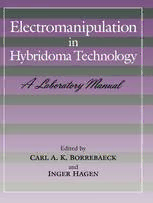
Electromanipulation in Hybridoma Technology: A Laboratory Manual PDF
Preview Electromanipulation in Hybridoma Technology: A Laboratory Manual
Electromanipulation in Hybridoma Technology A Laboratory Manual ELECTROMANIPULATION IN HYBRIDOMA TECHNOLOGY A Laboratory Manual Edited by Carl A.K. Borrebaeck and Inger Hagen M stockton press New York London Tokyo Melbourne Hong Kong © Stockton Press, 1989 All rights reserved. No part of this publication may be reproduced, or transmitted, in any form or by any means, without permission. Published in the United States and Canada by Stockton Press, 1990 15 East 26th Street, New York, N.Y. 10010 Library of Congress Cataloging-in-Publication Data Electromanipulation in hybridoma technology 1 edited by Carl Borrebaeck, and Inger Hagen. p. cm. Includes index. ISBN 978-0-333-51806-9 ISBN 978-1-349-11339-2 (eBook) DOI 10.1007/978-1-349-11339-2 1. Hybridomas. 2. Electrofusion. 3. Cell hybridization. I. Borrebaeck, Carl A. K., 1948- . II. Hagen, Inger. [DNLM: 1. Monoclonal antibodies. 2. Cell Fusion. 3. Electricity. 4. Hybridomas-cytology. QW 575 E38] QRI85.8.H93E36 1989 616.0T93-dc20 DNLMIDLC for Library of Congress 89-11317 CIP Published in the United Kingdom by MACMILLAN PUBLISHERS LTD, 1990 Distributed by Globe Book Services Ltd, Brunei Road, Houndmills, Basingstroke, Hants RG21 2XS, England British Library Cataloguing in Publication Data Electromanipulation in hybridoma technology. 1. Organisms. Hybridomas I. Borrebaeck, Carl A.K, 1948- II. Hagen, I. (Inger) 575.2'8 ISBN 978-0-333-51806-9 U.K. ISBN 978-0-333-51806-9 U.S. ISBN 978-0-935859-76-8 9 8 7 6 5 432 1 CONTRIBUTORS Mary K. Conrad National Institute on Drug Abuse Washington, D.C., U.S.A. Steven K.H. Foong Department of Pathology Stanford University School of Medicine Stanford, California, U.S.A. Petra Gessner Institute of Biotechnology University of Wiirzburg Wiirzburg, F.R.G. Mark C. Glassy Brunswick Biotechnetics San Diego, California, U.S.A. Russell Greig Director, Department of Cell Sciences Smith Kline and French Laboratories King of Prussia, Pennsylvania, U.S.A. Edward Henri Department of Cell Sciences Smith Kline and French Laboratories King of Prussia, Pennsylvania, U.S.A. Zelenka L. Jonak Department of Cell Sciences Smith Kline and French Laboratories King of Prussia, Pennsylvania, U.S.A. Mathew M.S. Lo ICI Pharmaceuticals ICI Americas, Inc. Wilmington, Delaware, U.S.A. Patrick Machy Department of Cell Sciences Smith Kline and French Laboratories King of Prussia, Pennsylvania, U.S.A. v vi Contributors Martin I. Mally Brunswick Biotechnetics San Diego, California, U.S.A. Deborah Matour Department of Cell Sciences Smith, Kline and French Laboratories King of Prussia, Pennsylvania, U.S.A. Lynette McMillan Department of Cell Sciences Smith Kline and French Laboratories King of Prussia, Pennsylvania, U.S.A. Susan Perkins Department of Pathology Stanford University School of Medicine Stanford, California, U.S.A. Steven Trulli Department of Cell Sciences Smith Kline and French Laboratories King of Prussia, Pennsylvania, U.S.A. Michaela Wander Institute of Biotechnology University of Wiirzburg Wiirzburg, F.R.G. Ulrich Zimmermann Institute of Biotechnology University of Wiirzburg Wiirzburg, F.R.G. PREFACE Production of mouse monoclonal antibodies is a routine procedure in many laboratories around the world. In most cases, the immortalization of immunocompetent B cells is performed by somatic cell hybridization using the chemical fusogen polyethylene glycol. However, this immortalization procedure is very inefficient with fusion frequencies in the range of 10-5-10-6, which is not acceptable, especially when the frequency of immune B cells is low. Today, one of the major obstacles to efficient production of human monoclonal antibodies is the immortalization step. During the late 1970s pioneering work was reported on the use of electrical pulses to fuse cells. This technique was eventually employed for the production of hybridomas and emerged as an alternative to overcome the shortcomings of existing methods. In particular, one aimed at increasing the low fusion frequencies and later also fusion of antigen-specific B cells, so called directed fusion. Severe technical problems arose immediately, however, when groups outside the pioneers applied this methodology to their individual hybridoma problems, and electrofusion has thus far never played the role of a new general immor talization technology. The first Workshop on ELECTROFUSION IN HYBRIDOMA TECHNOLOGY was held in Oslo, April 1988 in an attempt to bring the experts and the potential users together to sort out the problems and to answer the question: Is electrofusion a practical alternative in hybridoma formation? The Workshop clearly demonstrated the need for a laboratory manual, a "how-to" description of the recommended procedures, each delineated by an authority in the field. We trust that this manual will be invaluable to investigators who want to evaluate the technology and to apply it to their individual problem in hybridoma formation. May 1989 Carl A.K. Borrebaeck, D.Sc. Inger Hagen, Ph.D. Professor of Immunotechnology Head, Biotechnology Department Lund University Center for Industrial Research Lund, Sweden Oslo, Norway vii CONTENTS Preface, vii 1. Electroinjection and Electrofusion in Hypo-osmolar Solution, 1 Ulrich Zimmermann, Petra Gessner, Michaela Wander, and Steven KH Foung 2. Electroporation of Human Lymphoid Cells, 31 Zdenka L Jonak, Patrick Machy, Edward Henri, Lynette McMillan, Steven Trulli, Deborah Matour, and Russell Greig 3. Formation of Hybridomas Secreting Human Monoclonal Antibodies with Mouse-Human Fusion Partners, 47 Susan Perkins, Ulrich Zimmermann, Petra Gessner, and Steven KH Foung 4. Generating Immortalized Immunoglobulin-secreting Human Lymphocytes by Recombinant DNA Technology, 71 Martin L Mally and Mark C. Glassy 5. B-Cell Hybridoma Production by Avidin-Biotin Mediated Electrofusion, 89 Mary K Conrad and Mathew MS. Lo Index, 103 ix Electromanipulation in Hybridoma Technology A Laboratory Manual CHAPTER 1 Electroinjection and Electrofusion in Hypo-osmolar Solution Ulrich Zimmermann, Petra Gessner, Michaela Wander, and Steven KH. Foung
